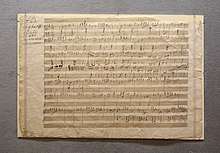Rage Over a Lost Penny
The "Rondo alla ingharese quasi un capriccio" in G major, Op. 129 (Italian for "Rondo in the Hungarian [i.e. gypsy] style, almost a caprice"), is a piano rondo by Ludwig van Beethoven.[1] It is better known by the title Rage Over a Lost Penny, Vented in a Caprice (from German: Die Wut über den verlorenen Groschen, ausgetobt in einer Caprice). This title appears on the autograph manuscript, but not in Beethoven's hand, and has been attributed to his friend Anton Schindler.[2] It is a favourite with audiences and is frequently performed as a showpiece.[2]

Music
Despite the late opus number, the work's composition has been dated between 1795 and 1798.[2] Beethoven left the piece unpublished and incomplete; it was published in 1828 by Anton Diabelli, who obscured the fact that it had been left unfinished.[2] The performance time runs between five and six minutes; the tempo of the piece is Allegro vivace (![]()
The indication alla ingharese is of interest, as no such word as "ingharese" exists in standard Italian. To people of Beethoven's day, "Gypsy music" and "Hungarian music" were synonymous terms. Beethoven seems to have conflated alla zingarese (in the Gypsy style) and all'ongarese (in the Hungarian style) to come up with a unique term alla ingharese.[3]
Robert Schumann wrote of the work that "it would be difficult to find anything merrier than this whim... It is the most amiable, harmless anger, similar to that felt when one cannot pull a shoe from off the foot," citing the work as an instance of Beethoven's earthliness against those fixated upon a transcendental image of the composer.[4]
See also
References
Notes
- "Rondo a capriccio für Klavier (G-Dur), Op. 129". Beethoven-Haus, Bonn. Retrieved 3 November 2011.
- Hertzmann, Erich (1946). "The Newly Discovered Autograph of Beethoven's "Rondo a Capriccio", Op. 129". The Musical Quarterly. 32 (2) (2): 171–95. doi:10.1093/mq/XXXII.2.171.
- van der Merwe, Peter (2007). Roots of the classical: the popular origins of western music. Oxford University Press. ISBN 978-0-19-921474-7.
- Schumann, Robert (1946). Konrad Wolf (ed.). On Music and Musicians. Translated by Paul Rosenfeld. University of California Press. p. 105. ISBN 0-520-04685-4.
Sources
- Barry Cooper, gen. ed., The Beethoven Compendium, Ann Arbor, MI: Borders Press, 1991, p. 247. ISBN 0-681-07558-9.
External links
- "Rage Over a Lost Penny": Scores at the International Music Score Library Project (IMSLP)
- "Rage Over a Lost Penny" on YouTube played by Evgeny Kissin
- Orchestral arrangement, Soundcloud.com